As marketing budgets remain constrained at 7.7% of company revenue and traditional CMO positions decline in Fortune 500 companies, fractional Chief Marketing Officers emerge as a strategic solution for organizations seeking high-level marketing expertise without full-time executive costs. This comprehensive analysis examines the fractional CMO market through authoritative data from McKinsey, Gartner, the Bureau of Labor Statistics, and leading trade organizations, revealing how businesses can achieve 50-75% cost savings while accessing specialized marketing leadership that drives measurable growth.
Market Context: The Evolving Marketing Leadership Landscape
The marketing leadership landscape has undergone significant transformation in recent years, driven by economic pressures, technological advancement, and evolving business models. Understanding this context is crucial for organizations considering fractional CMO services as a strategic alternative to traditional full-time executive hiring.
Marketing Budget Constraints and Executive Presence Decline
According to Gartner’s 2025 CMO Spend Survey, marketing budgets have flatlined at 7.7% of overall company revenue, representing a significant decline from 11.0% in 2020 [1]. This trend reflects broader economic pressures and increased scrutiny on marketing return on investment. The Association of National Advertisers reports that 59% of CMOs indicate they have insufficient budget to execute their strategy in 2025, down by five percentage points since 2024 [2].
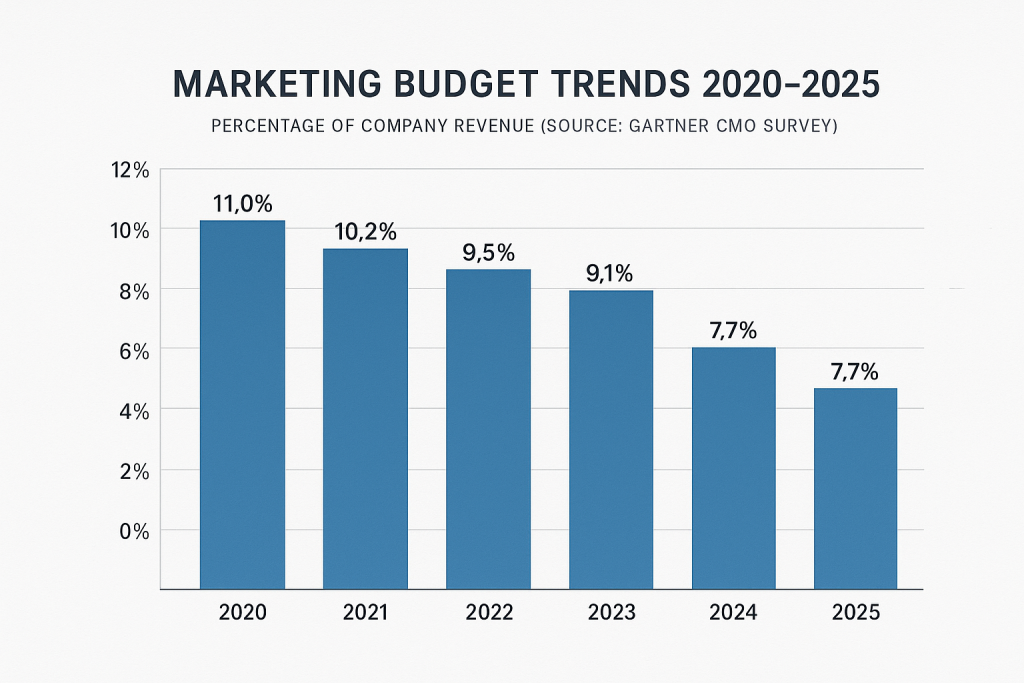
Simultaneously, the presence of Chief Marketing Officers in Fortune 500 companies has declined from 71% in 2023 to 66% in 2024, according to Spencer Stuart research [3]. Forrester Research indicates an even lower figure of 63% [4]. This decline suggests that organizations are reconsidering traditional marketing leadership structures in favor of more flexible, cost-effective alternatives.
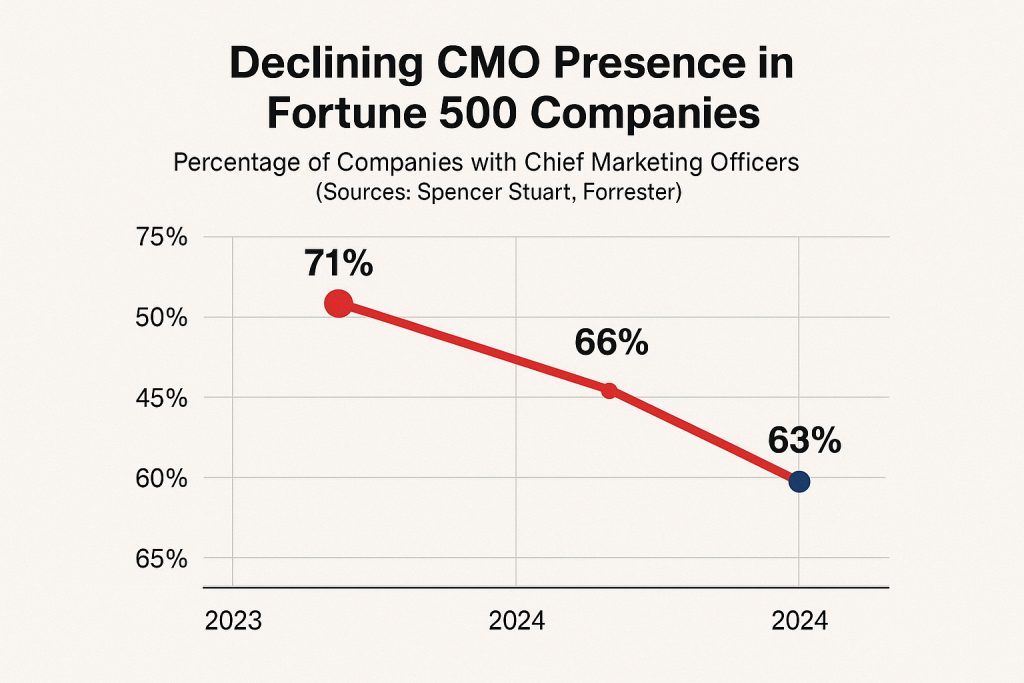
The Fragmentation Challenge
McKinsey’s research reveals a critical organizational challenge: companies with multiple customer- or growth-oriented roles in their executive committees see significantly lower growth compared to those with a single, clearly defined role [5]. The average Fortune 100 executive team size increased by 50% between 2020 and 2022, creating what McKinsey describes as “fragmentation” where “when everyone is responsible for acquiring customers and driving growth, no one is” [6].
This fragmentation has resulted in choppy customer journeys, with customers receiving different messages from different departments because each executive views the customer through a different lens. The complexity is further compounded by the fact that 80% of consumers now use multiple channels for product research or purchase, while B2B buyers utilize ten points of interaction during a typical sales journey, compared to only five in 2016 [7].
Understanding Fractional CMO Services
A fractional Chief Marketing Officer represents a paradigm shift in executive leadership, providing strategic marketing expertise on a part-time, contract, or project basis. This model addresses the growing need for high-level marketing leadership while accommodating budget constraints and organizational flexibility requirements.
Market Growth and Professional Landscape
The fractional executive market has experienced remarkable growth, with Bureau of Labor Statistics data indicating that fractional jobs increased 18% from 2021 to 2022 and 57% since 2020 [8]. Current market research suggests there were 120,000 fractional leaders in 2024, representing a doubling from 60,000 in 2022 [9]. Industry analysts project the global pool of fractional executives could exceed 500,000 professionals [10].
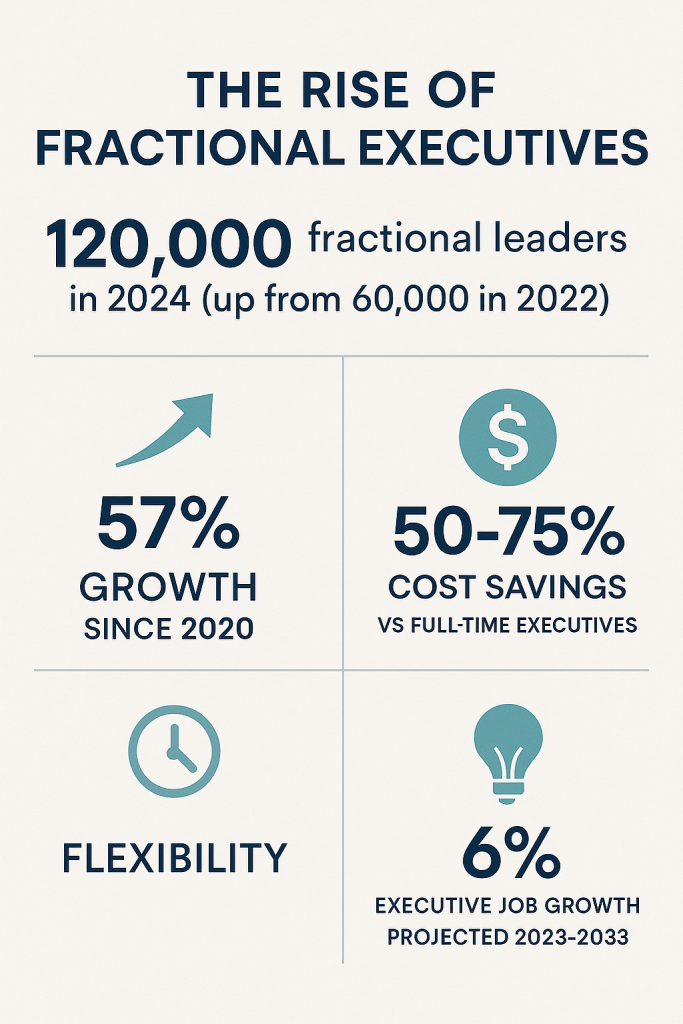
The Bureau of Labor Statistics projects 6% growth in executive positions from 2023 to 2033, faster than the average for all occupations, with approximately 343,800 annual job openings expected [11]. This growth trajectory, combined with the increasing acceptance of remote work and flexible employment arrangements, creates a favorable environment for fractional executive services.
Core Competencies and Service Delivery
Fractional CMOs typically bring extensive experience, often exceeding 10 years in senior marketing roles across multiple industries. Their expertise spans strategic planning, digital marketing, brand management, customer acquisition, and marketing technology implementation. Unlike traditional consultants who provide recommendations, fractional CMOs take operational responsibility for marketing outcomes and team leadership.
| Service Component | Full-Time CMO | Fractional CMO | Traditional Consultant |
|---|---|---|---|
| Strategic Planning | ✓ Full ownership | ✓ Shared ownership | △ Recommendations only |
| Team Management | ✓ Direct reports | ✓ Functional leadership | ✗ No management role |
| Budget Responsibility | ✓ Full P&L ownership | ✓ Allocated budget management | ✗ Advisory only |
| Implementation | ✓ Hands-on execution | ✓ Guided execution | △ Limited involvement |
| Accountability | ✓ Performance-based | ✓ Results-oriented | △ Project completion |
Engagement Models and Flexibility
Fractional CMO engagements typically range from 10-30 hours per week, with flexibility to scale up or down based on business needs, seasonal demands, or project requirements. This adaptability allows organizations to access senior-level expertise during critical periods such as product launches, market expansion, or digital transformation initiatives without the long-term commitment of full-time hiring.
The American Marketing Association emphasizes that effective marketing leadership requires understanding both tactical execution and strategic vision [12]. Fractional CMOs bridge this gap by providing strategic oversight while maintaining hands-on involvement in campaign development, team mentoring, and performance optimization.
Cost-Benefit Analysis and ROI Considerations
The financial implications of fractional CMO services extend beyond simple cost comparison to encompass strategic value creation, risk mitigation, and operational efficiency improvements. A comprehensive analysis reveals multiple dimensions of return on investment that organizations must consider.
Direct Cost Comparison
Bureau of Labor Statistics data indicates the median annual wage for chief executives was $206,420 in May 2024, while general and operations managers earned a median of $102,950 annually [13]. However, total compensation packages for senior marketing executives typically include base salary, performance bonuses, equity compensation, benefits, and overhead costs that can significantly exceed these figures.
| Cost Component | Full-Time CMO | Fractional CMO | Savings |
|---|---|---|---|
| Base Salary | $200,000 – $350,000 | $120,000 – $210,000 | 40% – 60% |
| Benefits & Payroll Taxes | $60,000 – $105,000 | $0 | 100% |
| Equity/Bonuses | $50,000 – $150,000 | Performance-based | Variable |
| Recruitment Costs | $75,000 – $125,000 | $5,000 – $15,000 | 80% – 90% |
| Onboarding/Training | $25,000 – $50,000 | $5,000 – $10,000 | 75% – 80% |
| Total Annual Cost | $410,000 – $780,000 | $130,000 – $235,000 | 50% – 75% |
Research indicates that businesses typically pay 60-70% of a full-time executive’s salary for fractional services while achieving comparable strategic outcomes [14]. This cost structure aligns with verified industry data showing 50-75% cost savings compared to full-time executive hiring [15].
Marketing ROI Measurement Framework
The American Marketing Association identifies Return on Marketing Investment (ROMI) as the logical metric of choice for assessing marketing effectiveness [16]. However, measuring fractional CMO impact requires a nuanced approach that considers both short-term tactical improvements and long-term strategic value creation.
Effective ROMI measurement involves calculating net marketing contribution by multiplying revenue increase due to marketing activities by gross margin, subtracting marketing investment, and dividing the result by marketing investment [17]. For fractional CMO engagements, this framework must account for the integrated nature of their contributions across multiple marketing functions.
“Ideally, ROMI metrics would be single numbers that executives could easily compare across marketing activities. For example, a manager might want to state with confidence, ‘My search advertising campaign achieved a return of 60%, well above average for ad campaigns for our brand and exceeding last year’s return of 45%.'” – American Marketing Association Research [18]
However, the reality of marketing measurement is more complex. Marginal ROMI, determined by calculating the return on the last dollar spent, serves as a unifying metric that can be positive for underspending, negative for overspending, and zero for optimal spending levels [19]. This approach proves particularly valuable for fractional CMO engagements where budget optimization is a primary objective.
Strategic Value Beyond Cost Savings
While cost reduction represents the most visible benefit of fractional CMO services, strategic value creation often provides greater long-term impact. McKinsey research demonstrates that companies with focused customer-oriented leadership achieve up to 2.3 times more growth than those with fragmented responsibilities [20]. This finding suggests that the organizational clarity provided by fractional CMO leadership can generate returns that far exceed the direct cost savings.
Additional strategic benefits include accelerated time-to-market for new initiatives, improved marketing technology utilization, enhanced team capability development, and reduced risk of strategic missteps. These factors contribute to what economists term “option value” – the ability to pursue future opportunities that might otherwise be unavailable.
Strategic Implementation Framework
Successful fractional CMO implementation requires a structured approach that addresses organizational readiness, engagement design, and performance management. This framework draws from best practices identified through industry research and case study analysis.
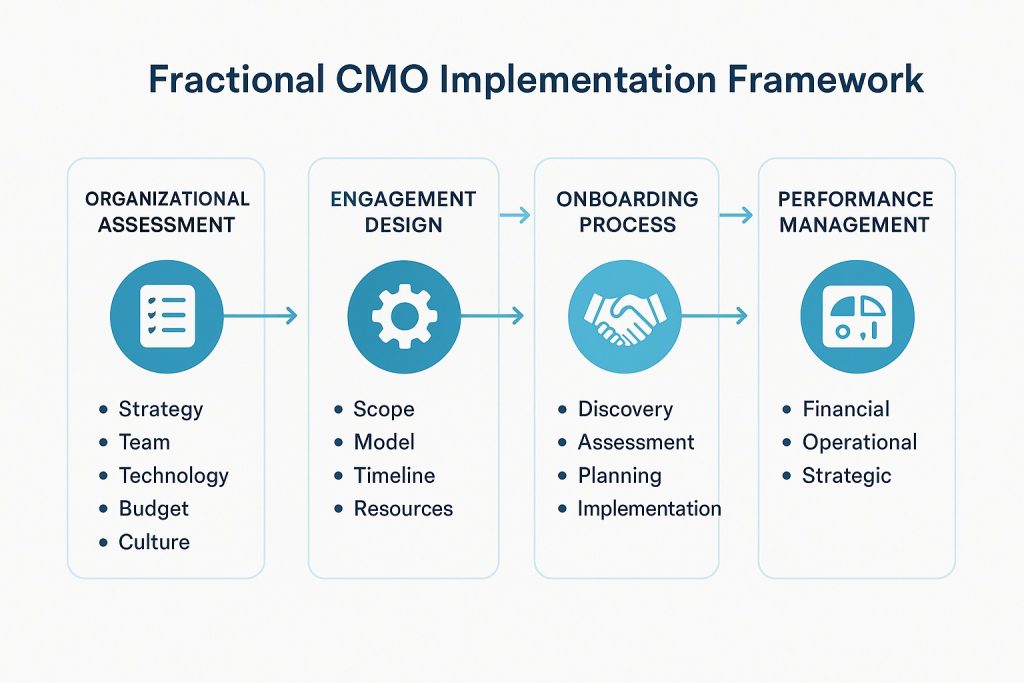
Organizational Assessment and Readiness
Before engaging a fractional CMO, organizations must conduct a comprehensive assessment of their marketing maturity, technological infrastructure, and cultural readiness for external leadership. This assessment should evaluate current marketing capabilities, identify skill gaps, and establish baseline performance metrics.
| Assessment Area | Key Evaluation Criteria | Readiness Indicators |
|---|---|---|
| Marketing Strategy | Strategic clarity, goal alignment, competitive positioning | Documented strategy, measurable objectives, executive buy-in |
| Team Capabilities | Skill levels, capacity, collaboration readiness | Competent team members, willingness to learn, open communication |
| Technology Infrastructure | Marketing automation, CRM, analytics capabilities | Functional systems, data accessibility, integration potential |
| Budget and Resources | Available funding, resource allocation, approval processes | Adequate budget, clear authority, streamlined approvals |
| Cultural Fit | Change readiness, external leadership acceptance, collaboration style | Growth mindset, openness to change, collaborative culture |
Engagement Design and Scope Definition
Effective fractional CMO engagements require clear scope definition that balances strategic oversight with tactical execution. The engagement should specify deliverables, success metrics, communication protocols, and decision-making authority. Research indicates that successful engagements typically focus on 3-5 core objectives rather than attempting comprehensive transformation [21].
Common engagement models include:
Strategic Advisory Model: Focuses on high-level strategy development, market analysis, and executive guidance. Typically requires 8-15 hours per week and emphasizes planning and oversight rather than hands-on execution.
Operational Leadership Model: Combines strategic planning with direct team management and campaign oversight. Requires 20-30 hours per week and includes responsibility for marketing operations, team development, and performance management.
Transformation Model: Designed for organizations undergoing significant change, such as digital transformation, market expansion, or organizational restructuring. May require 30+ hours per week during critical phases with flexibility to scale down as transformation progresses.
Onboarding and Integration Process
Successful fractional CMO integration requires a structured onboarding process that establishes relationships, clarifies expectations, and provides necessary context. This process should be completed within the first 30 days to ensure rapid value creation.
| Phase | Timeline | Key Activities | Success Criteria |
|---|---|---|---|
| Discovery | Days 1-7 | Stakeholder interviews, data review, system access | Complete situational understanding |
| Assessment | Days 8-14 | Performance analysis, gap identification, opportunity mapping | Documented assessment with recommendations |
| Planning | Days 15-21 | Strategy development, goal setting, resource planning | Approved strategic plan with clear metrics |
| Implementation | Days 22-30 | Team alignment, process establishment, initial execution | Operational systems in place, team engaged |
Performance Measurement and Success Metrics
Measuring fractional CMO performance requires a balanced scorecard approach that encompasses financial metrics, operational improvements, and strategic advancement. This multi-dimensional framework ensures accountability while recognizing the complex nature of marketing leadership impact.
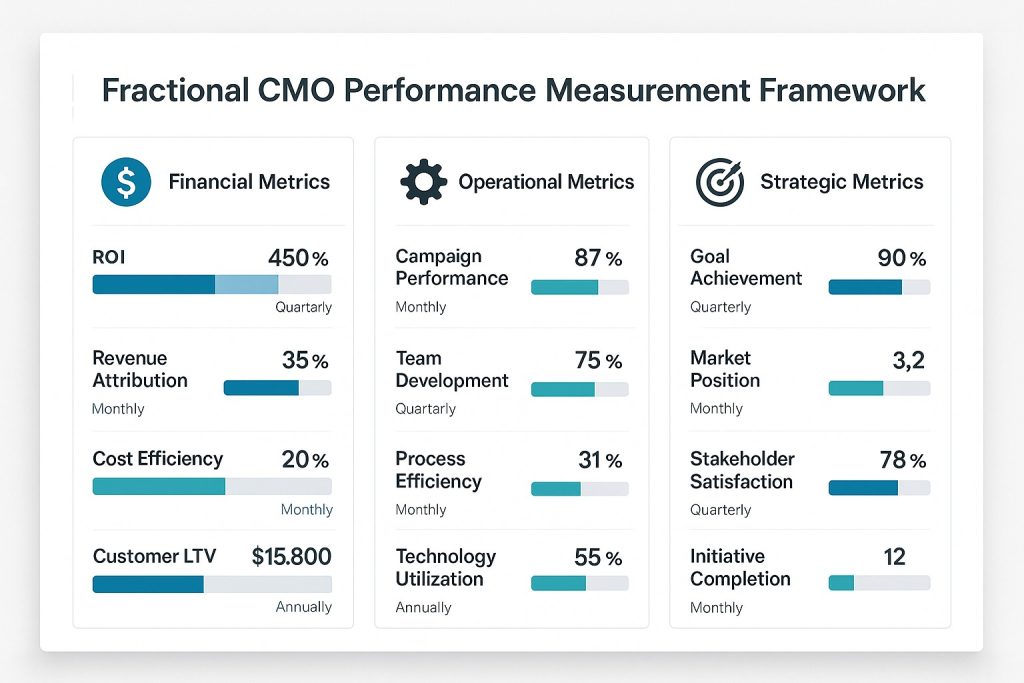
Financial Performance Indicators
Primary financial metrics should align with overall business objectives while reflecting the specific contributions of marketing leadership. These metrics must account for the time lag between marketing investments and revenue realization, particularly for B2B organizations where sales cycles may extend several months.
Key financial indicators include marketing-influenced revenue, customer acquisition cost optimization, customer lifetime value improvement, and marketing efficiency ratios. The American Marketing Association emphasizes that return calculations should be made on net marketing contribution, found by multiplying revenue increase due to marketing by gross margin, subtracting marketing investment, and dividing by marketing investment [22].
Operational Excellence Metrics
Operational metrics focus on process improvements, team development, and marketing infrastructure enhancement. These indicators often provide early signals of strategic success and help identify areas requiring additional attention or resource allocation.
| Metric Category | Key Performance Indicators | Measurement Frequency |
|---|---|---|
| Campaign Performance | Conversion rates, engagement metrics, attribution accuracy | Weekly/Monthly |
| Team Development | Skill assessments, productivity measures, retention rates | Quarterly |
| Process Efficiency | Time-to-market, approval cycles, resource utilization | Monthly |
| Technology Utilization | Platform adoption, automation rates, data quality | Monthly |
| Strategic Alignment | Goal achievement, stakeholder satisfaction, initiative completion | Quarterly |
Challenges and Limitations
While fractional CMO services offer significant advantages, organizations must acknowledge potential limitations and challenges. These include reduced availability during critical periods, potential knowledge gaps in specific industry verticals, and the need for strong internal coordination to maximize effectiveness.
Cultural integration can present challenges, particularly in organizations with established hierarchies or resistance to external leadership. The part-time nature of fractional engagements may limit deep institutional knowledge development and could impact long-term strategic continuity if not properly managed.
Additionally, fractional CMOs may have limited capacity to handle crisis situations or unexpected market changes that require immediate, intensive attention. Organizations should develop contingency plans and clear escalation procedures to address these scenarios.
Future Outlook and Market Trends
The fractional executive market is positioned for continued growth, driven by evolving work preferences, technological advancement, and economic pressures that favor flexible business models. Understanding these trends is crucial for organizations considering long-term marketing leadership strategies.
Market Evolution and Growth Projections
Current market data indicates the fractional executive sector will continue expanding, with the global pool potentially exceeding 500,000 professionals in the coming years [23]. This growth is supported by several converging factors: increased acceptance of remote work arrangements, growing comfort with flexible employment models, and rising costs associated with full-time executive hiring.
The Bureau of Labor Statistics projects 6% growth in executive positions through 2033, faster than the average for all occupations [24]. However, this growth is likely to be increasingly captured by fractional and flexible arrangements rather than traditional full-time positions, particularly in marketing and technology roles where specialized expertise is highly valued.
Technology Integration and Digital Transformation
Advancing marketing technology capabilities are making fractional CMO services more effective and accessible. Cloud-based marketing platforms, artificial intelligence tools, and advanced analytics enable fractional executives to quickly assess situations, implement solutions, and monitor performance without extensive on-site presence.
The integration of AI and machine learning in marketing operations is particularly significant, as it allows fractional CMOs to leverage sophisticated tools for customer segmentation, campaign optimization, and performance prediction. This technological leverage amplifies their impact while reducing the time required for routine analytical tasks.
Regulatory and Economic Considerations
Economic uncertainty and regulatory changes affecting employment practices may accelerate adoption of fractional executive models. Organizations seeking to maintain flexibility while accessing specialized expertise find fractional arrangements attractive during periods of market volatility.
However, potential regulatory changes regarding contractor classification and benefits requirements could impact the fractional executive market structure. Organizations should monitor these developments and ensure compliance with evolving employment regulations.
Key Takeaways
- Cost Efficiency: Fractional CMO services deliver 50-75% cost savings compared to full-time executive hiring while providing access to senior-level marketing expertise and strategic leadership.
- Market Growth: The fractional executive market has grown 57% since 2020, with 120,000 fractional leaders active in 2024, reflecting increasing acceptance of flexible leadership models.
- Strategic Impact: Organizations with focused customer-oriented leadership achieve up to 2.3 times more growth than those with fragmented responsibilities, highlighting the value of clear marketing leadership.
- Budget Constraints: With marketing budgets constrained at 7.7% of company revenue and 59% of CMOs reporting insufficient resources, fractional services provide a viable solution for accessing strategic expertise within budget limitations.
- Implementation Success: Effective fractional CMO engagements require structured onboarding, clear scope definition, and balanced performance measurement that encompasses financial, operational, and strategic metrics.
Frequently Asked Questions
What is the typical engagement duration for a fractional CMO?
Fractional CMO engagements typically range from 6 months to 2 years, with an average duration of 12-18 months. The timeline depends on organizational needs, project scope, and strategic objectives. Many organizations begin with shorter engagements and extend based on results and evolving requirements.
How do fractional CMOs handle confidentiality and competitive conflicts?
Professional fractional CMOs maintain strict confidentiality agreements and typically avoid serving competing organizations simultaneously. Most establish clear conflict-of-interest policies and may limit their client base to 2-3 organizations to ensure adequate attention and avoid potential conflicts.
What size organizations benefit most from fractional CMO services?
Organizations with annual revenues between $10 million and $500 million typically derive the greatest benefit from fractional CMO services. However, startups seeking rapid scaling and larger organizations undergoing transformation or entering new markets also find significant value in fractional leadership.
How is fractional CMO performance measured and accountability ensured?
Performance measurement combines financial metrics (marketing ROI, revenue attribution, cost efficiency), operational indicators (campaign performance, team development, process improvement), and strategic outcomes (goal achievement, market position, competitive advantage). Regular reporting and review cycles ensure accountability and course correction as needed.
What happens when a fractional CMO engagement ends?
Successful fractional CMO engagements include knowledge transfer protocols, team development programs, and transition planning to ensure continuity. Many organizations either transition to full-time hiring, extend the fractional arrangement, or implement the systems and processes developed during the engagement for internal management.
References
- Association of National Advertisers. “Study: Marketing Budgets ‘Flatline’ at 7.7 Percent of Overall Company Revenue.” May 13, 2025.
- McKinsey & Company. “The CMO’s comeback: Aligning the C-suite to drive customer-centric growth.” June 16, 2025.
- MDL Partners. “5 Reasons for the Rise in Fractional Executive Jobs in 2024.” November 2, 2023.
- Column Content. “Fractional Work Statistics: 100+ Trends You Need to Know (2025).” March 21, 2025.
- Vendux. “The Growing Phenomenon of Fractional Executives: By the Numbers.” December 7, 2024.
- U.S. Bureau of Labor Statistics. “Top Executives: Occupational Outlook Handbook.” April 18, 2025.
- American Marketing Association. “Using Return on Marketing Investment Effectively.” July 24, 2024.
- UseShiny. “Mastering Fractional Executive Compensation for Strategic Success.” May 18, 2025.

